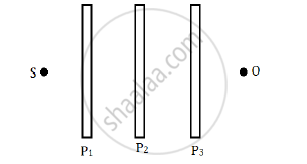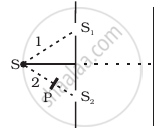Advertisements
Advertisements
Question
Three identical polaroid sheets P1, P2 and P3 are oriented so that the pass axis of P2 and P3 are inclined at angles of 60° and 90° respectively with the pass axis of P1. A monochromatic source S of unpolarised light of intensity I0 is kept in front of the polaroid sheet P1 as shown in the figure. Determine the intensities of light as observed by the observer at O, when polaroid P3 is rotated with respect to P2 at angles θ = 30° and 60°.

Solution

The ray of light passing through polaroid P1 will have intensity reduced by half.'
`I_1=I_0/2`
Now, the polaroid P2 is oriented at an angle 60° with respect to P1.
Therefore, the intensity is
`I_2=I_1cos^2 60=I_0/2xx1/4=I_0/8`
Now, the polaroid P3 is originally oriented at an angle 90 − 60 = 30°. Hence, when P3 is rotated by 30°, the angle between P2 and P3 is 60°. Therefore, the intensity is
`I_3=I_2cos^2 60=I_0/8cos^2 60=I_0/8xx1/4=I+0/32`
Similarly, when P3 is rotated by 60°, the angle between P2 and P3 is 90°.
Therefore, the intensity is `I_3=I_2cos^2 90=I_0/8xx0xx0`
APPEARS IN
RELATED QUESTIONS
For a glass plate as a polariser with refractive index 1.633, calculate the angle of incidence at which light is polarised.
Show, using a simple polaroid, that light waves are transverse in nature. Intensity of light coming out of a polaroid does not change irrespective of the orientation of the pass axis of the polaroid. Explain why.
How does one demonstrate, using a suitable diagram, that unpolarised light when passed through a Polaroid gets polarised?
Using the phenomenon of polarisation, show how the transverse nature of light can be demonstrated.
A ray of light passes from a vacuum to a medium of refractive index (μ). The angle of
incidence is found to be twice the angle of refraction. The angle of incidence is _______.
A) `cos^(-1)(mu/2)`
B) cos−1(μ)
C) `2 cos^(-1) (mu/2)`
D) `2 sin^(-1) (mu/2)`
A beam of light is incident at the polarizing angle of 35° on a certain glass plate. The refractive index of the glass plate is :
A ray of light is incident on a transparent medium at a polarizing angle. What is the angle between the reflected ray and the refracted ray?
Light transmitted by Nicol prism is ______.
State Brewster’s law.
Figure shown a two slit arrangement with a source which emits unpolarised light. P is a polariser with axis whose direction is not given. If I0 is the intensity of the principal maxima when no polariser is present, calculate in the present case, the intensity of the principal maxima as well as of the first minima.

